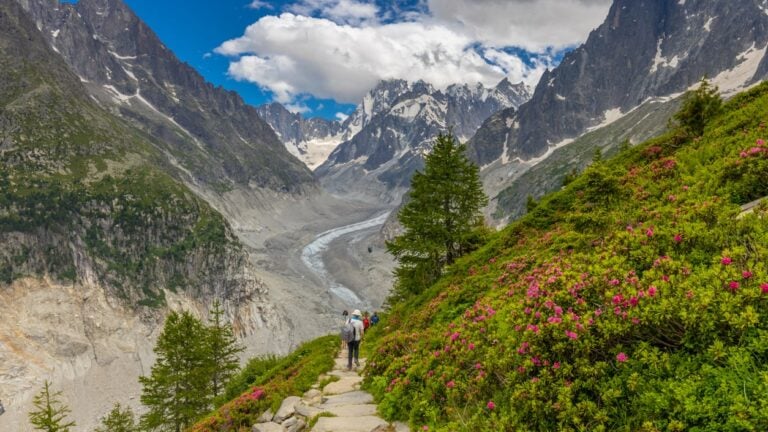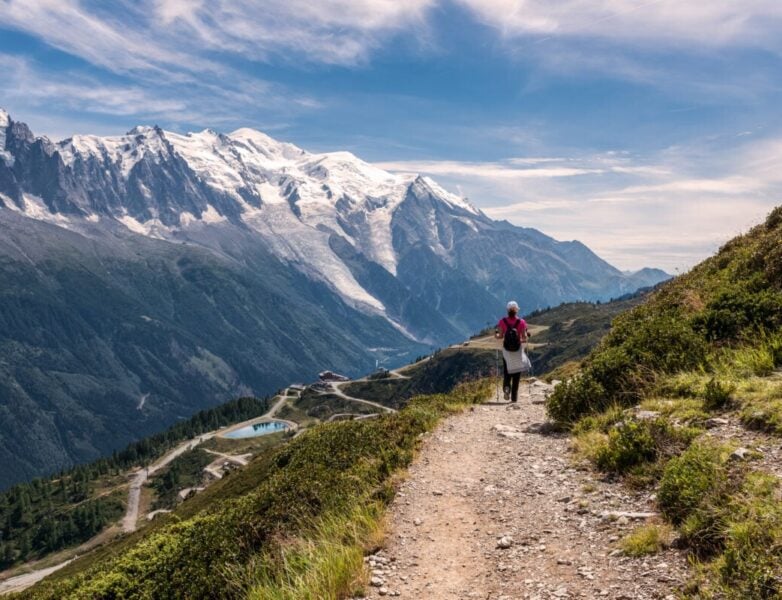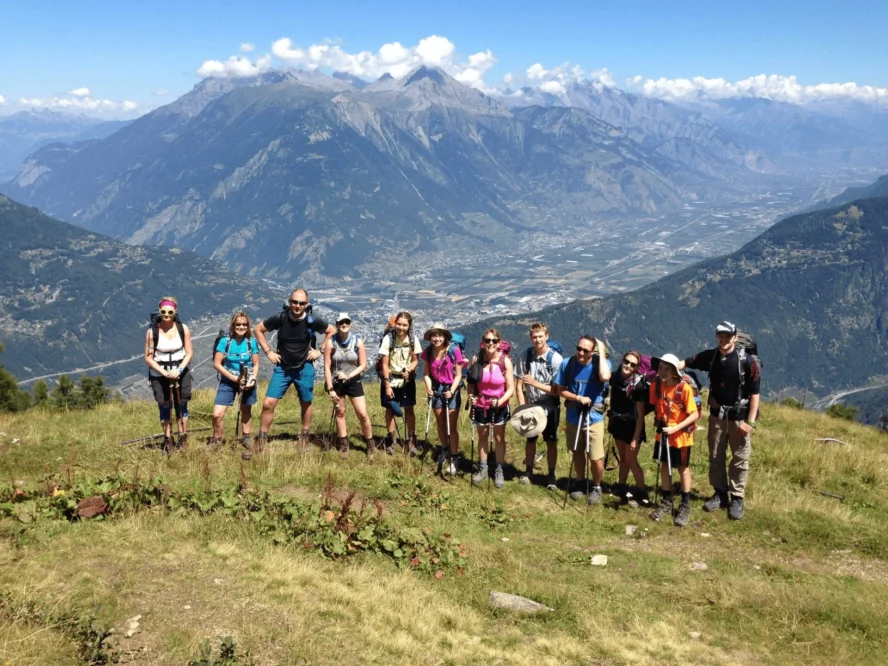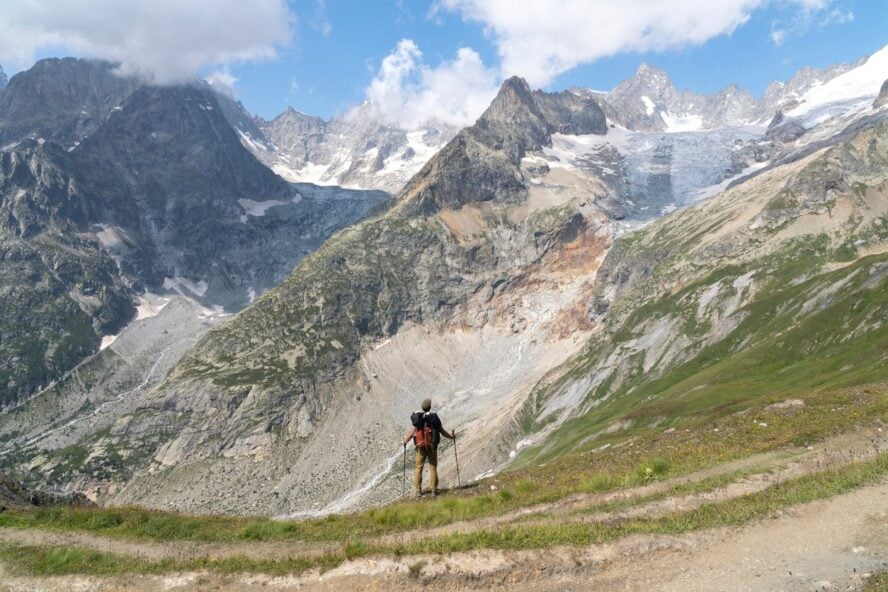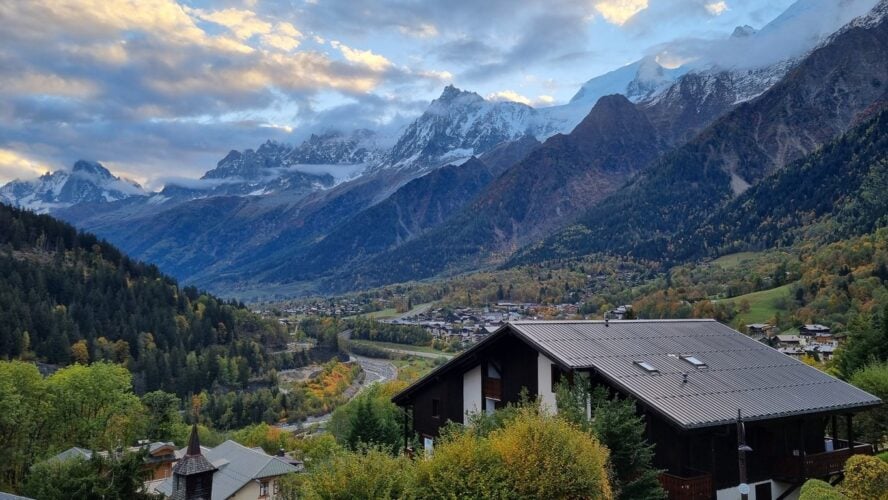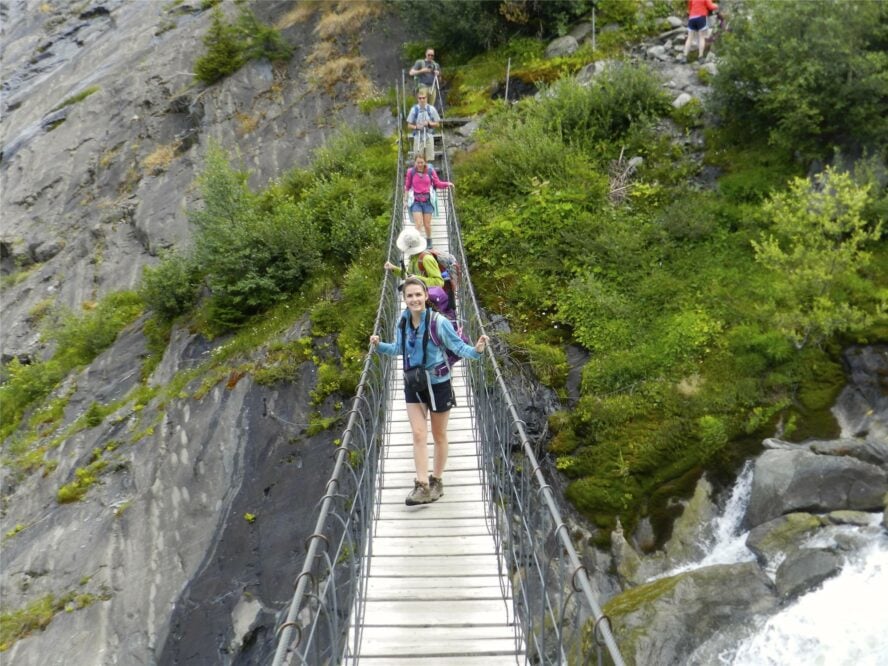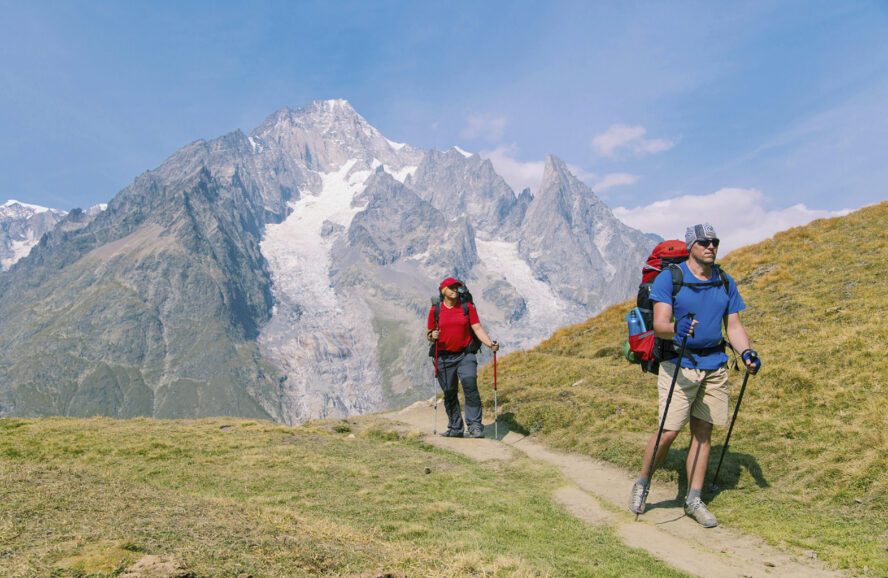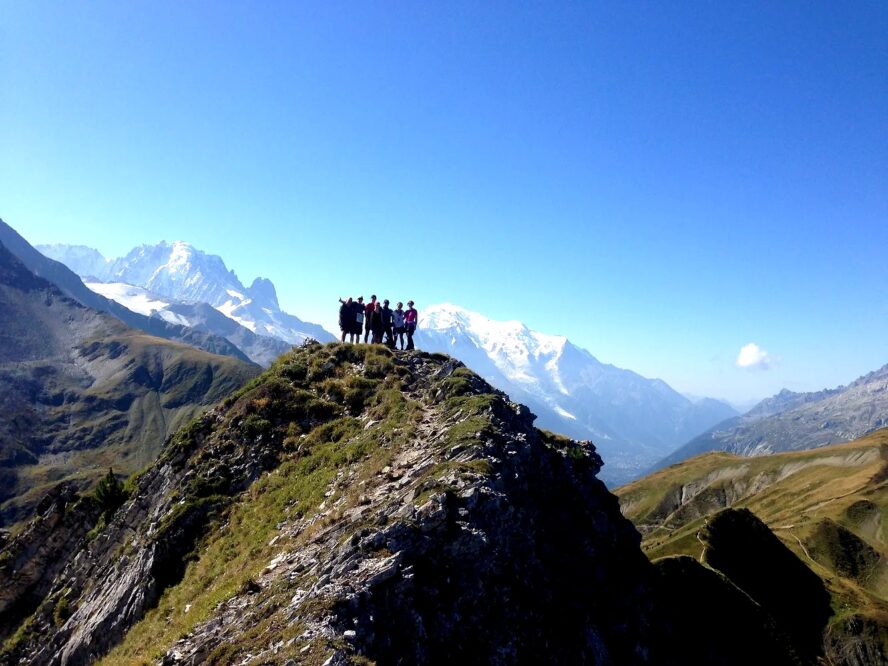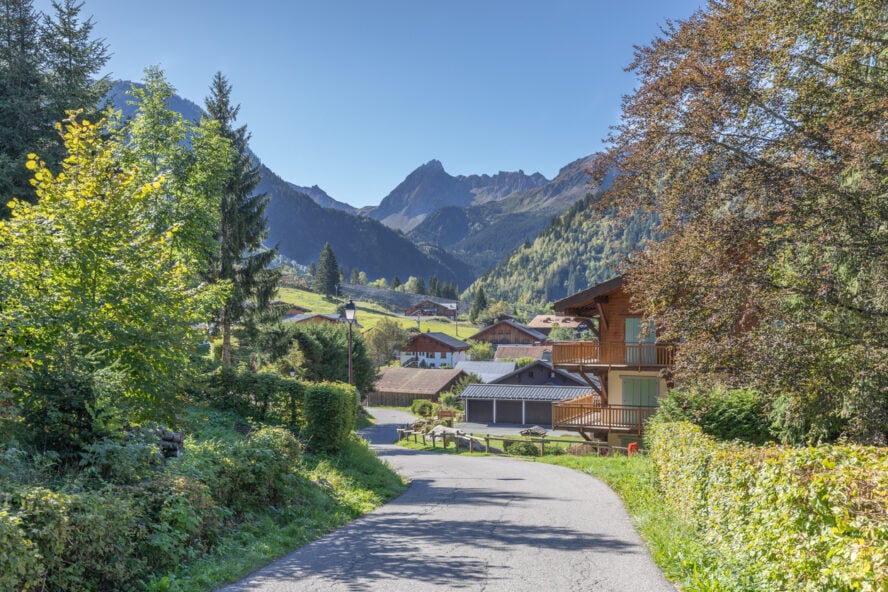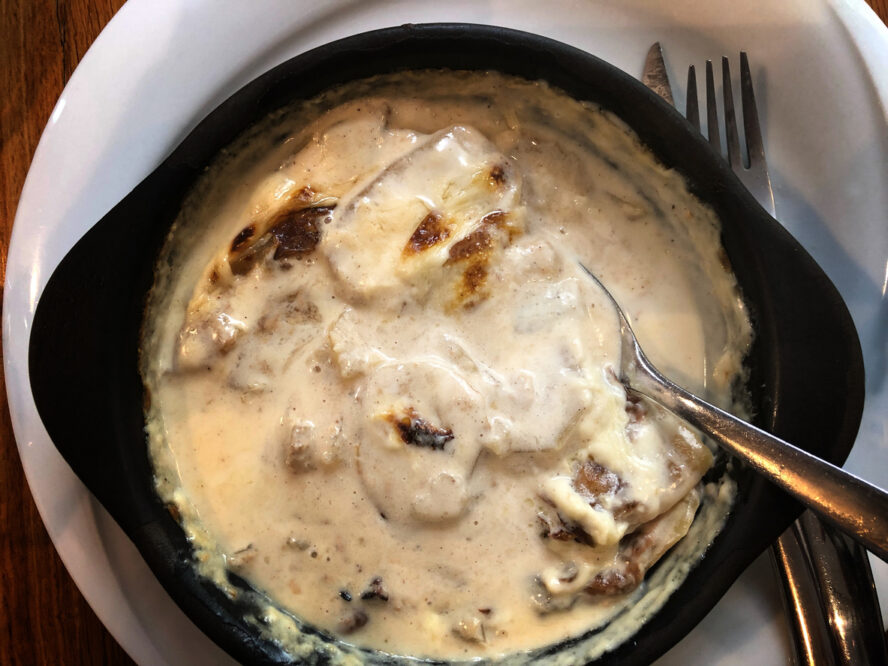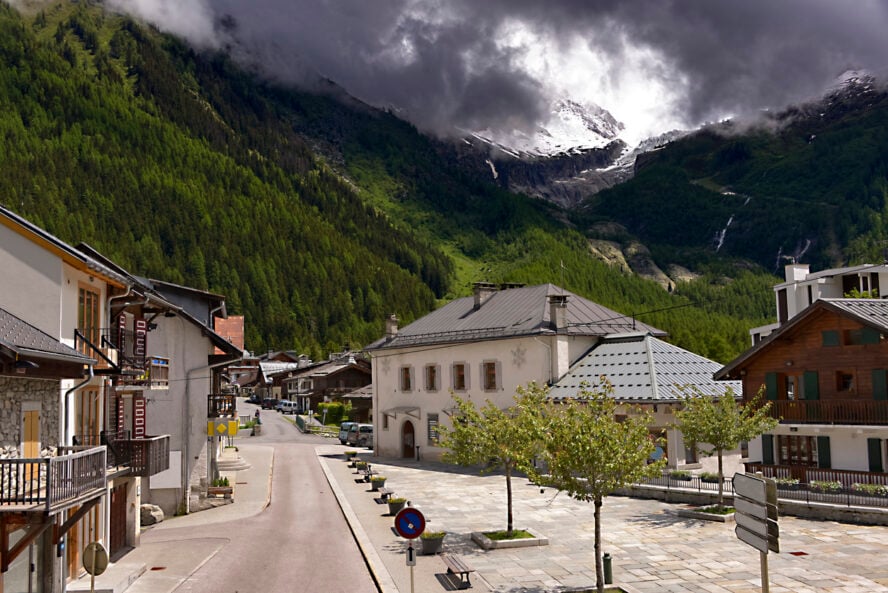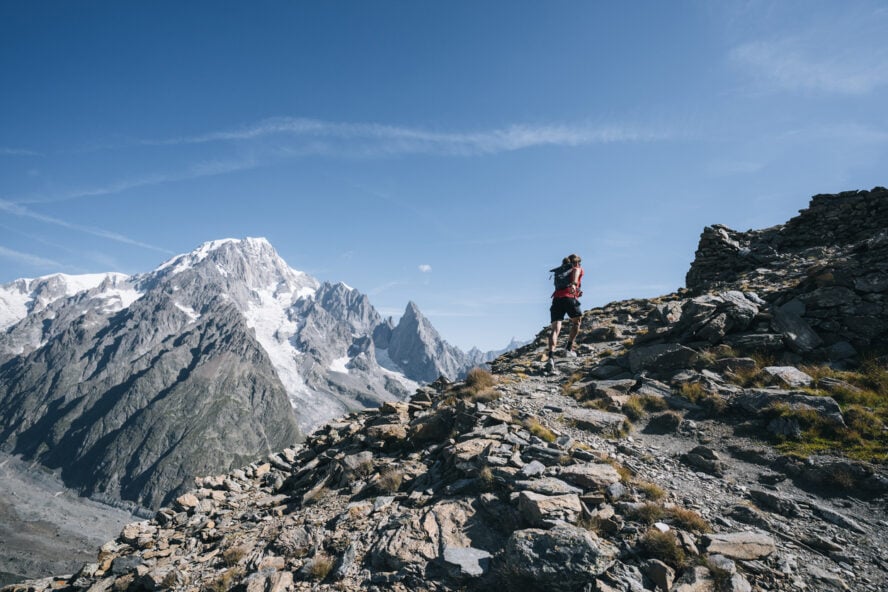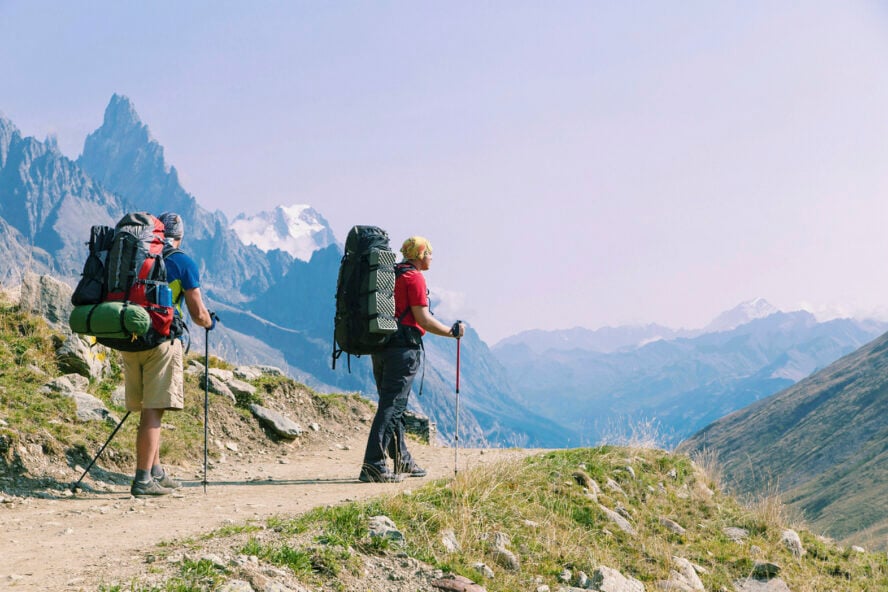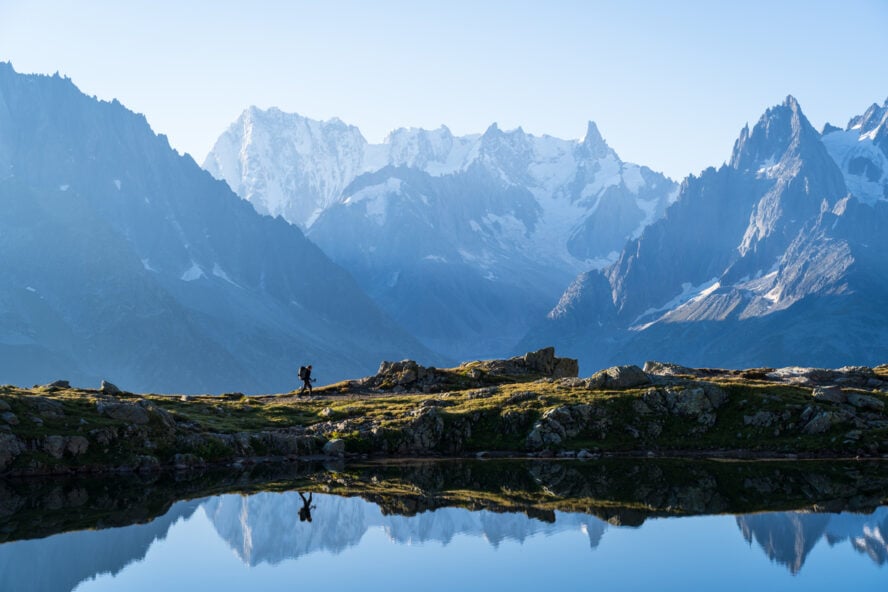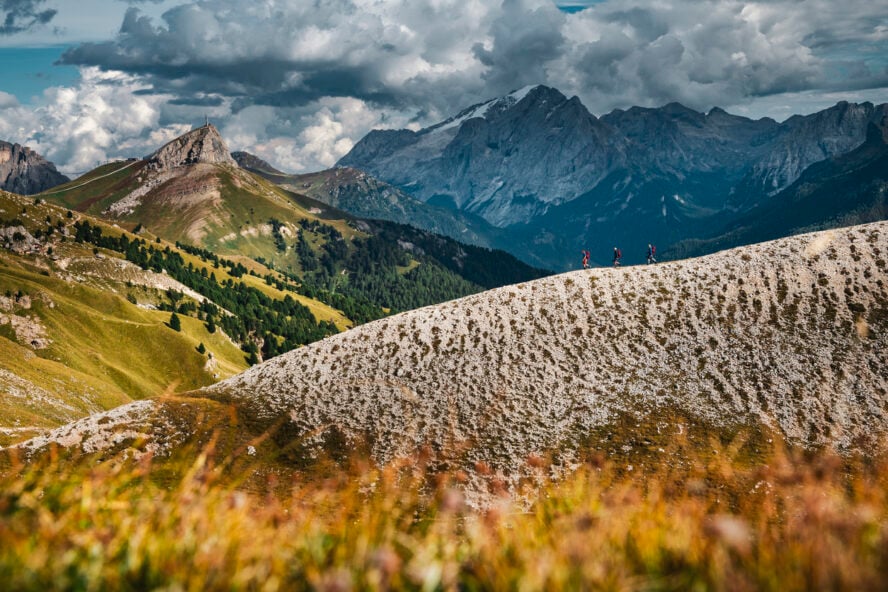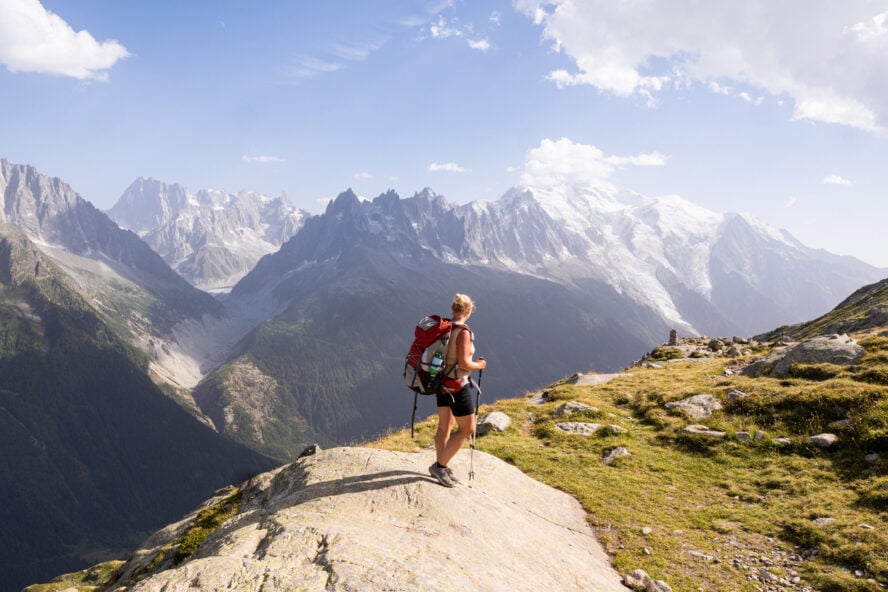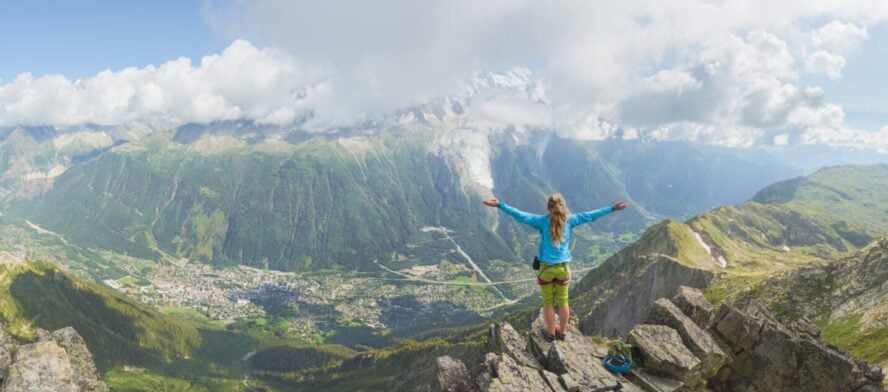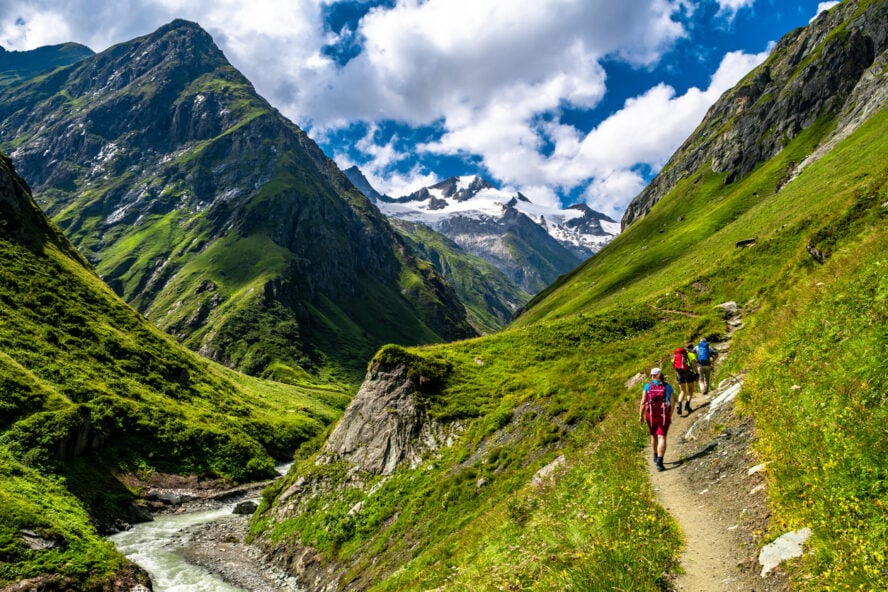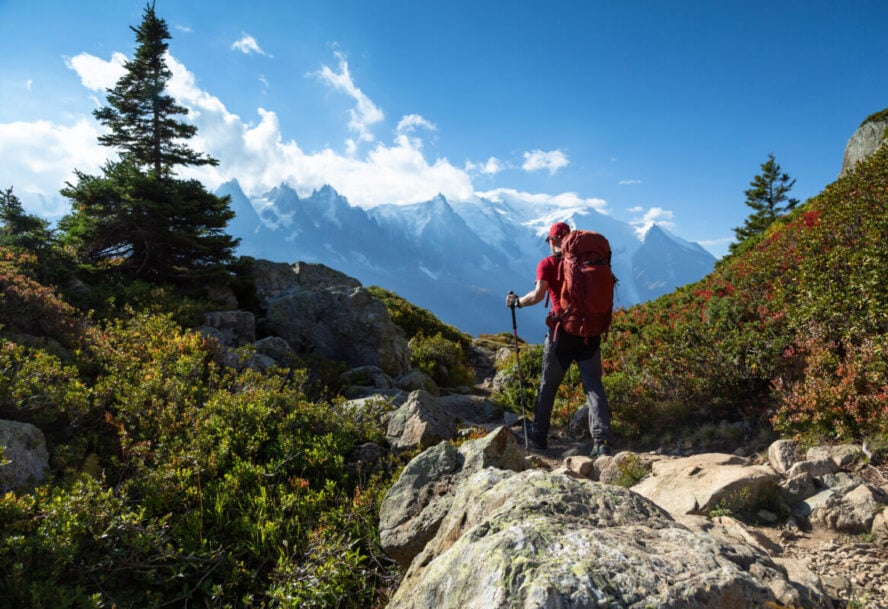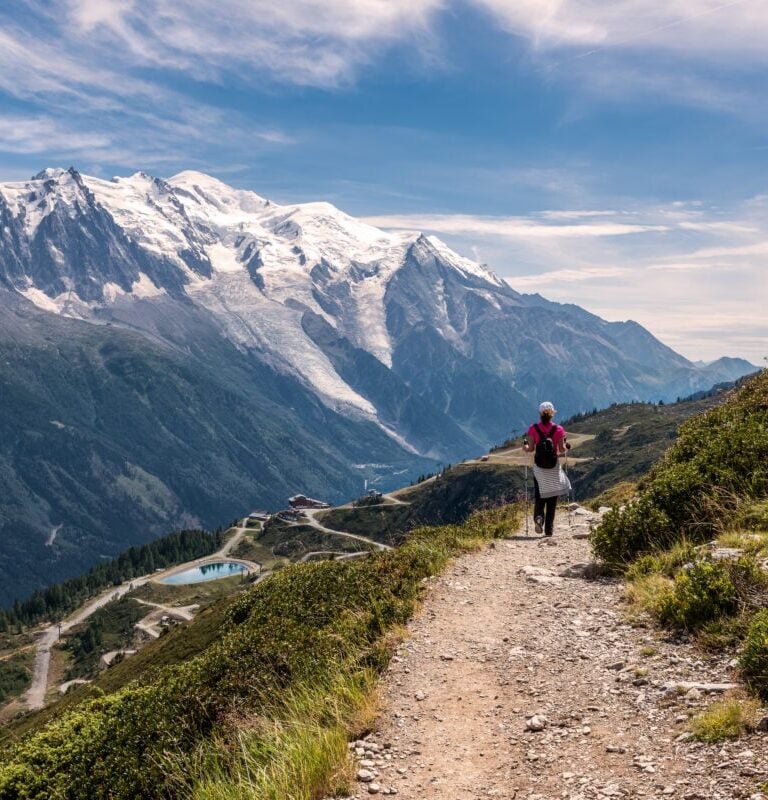I’m halfway up a thousand-meter climb, sweat dripping down my back, and Mont Blanc is shining in the afternoon sun like a giant beacon of white and gold.
My legs are burning, but I don’t mind. This is what the Tour du Mont Blanc is all about. It’s hard work, but it’s also one of the most rewarding experiences you can have on two feet.
Every step brings you closer to sweeping alpine vistas, cozy mountain huts, and the satisfaction of circling the highest peak in Western Europe.
If you’ve ever thought about taking on this legendary trek, I’m here to share my Tour du Mont Blanc tips, acquired straight from my years of guiding in the region—and over 50 successful TMB hikes!
Why the Tour du Mont Blanc Captivates Hikers
I’ve been living in the Alps since 1999, and the Tour du Mont Blanc hike has been a constant companion throughout my career as a hiking guide.
It’s more than just a trail. It’s a journey packed with cultural immersion through three countries (France, Italy, and Switzerland), each with its own landscapes, cultures, and flavors.
The scenery is jaw-dropping: jagged peaks, flower-strewn meadows, and glaciers that tumble down into valleys dotted with villages.
But what makes the Tour truly special is how accessible it is. You don’t need to be a seasoned trekker to do it. you just need a good pair of legs, a bit of stamina, and the will to put one foot in front of the other.
For many people, this is their first long-distance trek, and that’s part of its appeal. It’s challenging, yes, but it’s also sociable, well-supported, and flexible.
Want to stay in rustic mountain huts, camp under the stars, or retreat to a luxury hotel at the end of the day? The Tour du Mont Blanc can accommodate you, and my tips will get you set for the show!
The Tour du Mont Blanc: An Overview
So, before we get into the tips, what exactly is the Tour du Mont Blanc?
In simple terms, it’s a 170-kilometer loop around Mont Blanc, usually completed in 7 to 11 days. Hikers cross three countries, climb and descend an average of 1,000 meters a day, and pass through valleys filled with alpine cows, wildflowers, and postcard-perfect villages.
The trail is well-marked, and you’ll never be far from a mountain hut, cable car, or town. This makes it feel accessible even though you’re tackling big alpine terrain, and that’s exactly why it’s such a popular choice for people attempting their first multi-day trek.
1) Don’t Sleep On Chamonix
One of my biggest Tour du Mont Blanc tips? Spend some time in Chamonix.
The Mont Blanc massif is the beating heart of the Alps. Chamonix, the lively mountain town at its center, has been attracting adventurers for centuries.
Unlike some ski resorts that become ghost towns outside of winter, Chamonix thrives year-round. There are cultural activities, local communities, and, of course, endless opportunities to head into the mountains.
What I love about living here is how easy it is to access the outdoors. Cable cars can whisk you up to nearly 4,000 meters at the Aiguille du Midi, and countless lifts make even big ascents manageable.
It means you can design hikes that suit your energy. It doesn’t matter if the group is up for a big climb or just wants to stroll and enjoy the view.
And while the Tour du Mont Blanc is the star of the show, it’s far from the only trek worth mentioning. Other classics include:
- The Haute Route: From Chamonix to Zermatt, linking Mont Blanc to the Matterhorn.
- Tour de Monte Rosa: A rugged circuit around another alpine giant.
- Tour du Matterhorn, Tour des Combins, and the Bernese Oberland treks.
Then there are hidden gems like the Tour des Fiz or the Tour des Muverans. These are lesser-known circuits where you’ll have jaw-dropping views with hardly another soul in sight.
2) Make Sure You’re Ready for the Hike
Let’s be honest: the Tour du Mont Blanc isn’t a walk in the park.
On most days, you’ll be covering 15–20 kilometers with around 1,000–1,200 meters of elevation gain and the same in descent. Some days are longer, like the 1,700-meter descent from the Brévent into Les Houches. And if you choose some of the high variants, you might be climbing up to 2,000 meters in a single day.
That said, the TMB is manageable for most reasonably fit people. If you hike regularly, go to the gym, or do endurance sports, you’ll likely find the challenge tough but doable.
What surprises many first-timers is just how relentless the climbs can be. It’s not unusual to spend three or four hours going uphill without a break. So if you’re learning how to hike the Tour du Mont Blanc, focus on building endurance and getting your legs used to steady uphill walking.
My three Tour du Mont Blanc training tips:
- Simulate long climbs by doing hill repeats or stair sessions with a weighted pack.
- Practice back-to-back hiking days to get used to cumulative fatigue.
- Don’t underestimate the descents. Train your quads and knees to handle long downhill stretches.
3) Explore the Variants and Alternatives
One of my favorite things about the TMB is the network of variants, alternative routes that branch off the main trail. These often take you higher, further, and away from the crowds, rewarding you with incredible views.
- Mont de la Saxe Ridge (Courmayeur to Rifugio Bonatti): My personal favorite. It’s longer and tougher than the standard route, but the views of Mont Blanc from this ridge are the best on the entire TMB.
- Col des Fours (France): A high variant that adds adventure and solitude.
- Fenêtre d’Arpette (Switzerland): A dramatic pass, but one that can hold snow well into July and is prone to rockfall. I only do this variant when conditions are safe.
These routes are where the Tour du Mont Blanc shines. Yes, the main Tour du Mont Blanc itinerary is beautiful, but if you want the best views and fewer people, don’t skip the variants.
4) Clockwise or Counterclockwise?
This is one of the most common questions I get as a guide. Most people hike the TMB counterclockwise, and that’s my preference too.
Here’s why: if you start in Les Houches and go clockwise, your very first day is a brutal ascent up to the Brévent. It’s a massive climb to tackle on day one, when your legs aren’t yet acclimatized. By doing it counterclockwise, you save that climb for the end, when you’re stronger, more used to the effort, and can always take the cable car down if your knees have had enough.
That said, the views are stunning in both directions. Sometimes, if accommodation is tight, it actually makes sense to go clockwise just to fit the booking puzzle together. Either way, you’ll have an unforgettable experience.
5) There’s Lots of Accommodations – If You Book In Advance
One of the joys of the Tour du Mont Blanc is the variety of accommodation. You can tailor your trip depending on your style and budget:
- Mountain huts (refuges): Dormitory-style, communal meals, and a lively atmosphere. These huts are part of the TMB experience; swapping stories over pasta and wine after a big day.
- Hotels and guesthouses: In towns and villages, you’ll find everything from simple guesthouses to five-star luxury chalets. Some hikers choose to mix huts with hotels for comfort.
- Camping: There are official campsites all around the Tour du Mont Blanc, and in some areas, designated bivouac spots where you can wild camp.
The key thing to know: accommodation is in extremely high demand.
Since the epidemic, interest in the Tour du Mont Blanc has skyrocketed, and huts now book out a year in advance. Some open reservations as early as September for the following summer, while others don’t open until late winter. If you’re planning your own trip, start as early as possible.
Another consideration is luggage transfers. On the Tour du Mont Blanc, it’s possible to have your bags transported most nights, except to the high huts. That means you can hike with just a daypack, which makes a big difference on those long climbs.
Tips for booking your Tour du Mont Blanc accommodation:
- Be flexible with dates and direction to secure huts.
- Book as soon as reservations open (often 9–12 months ahead).
- Consider mixing huts with hotels to break up dorm nights.
6) Don’t Worry About the Food
If you’re worried about going hungry, don’t be. One of the best things about the TMB is the food.
Every hut serves dinner and breakfast, and you can usually order a packed lunch for the next day. In the evenings, you’ll be treated to hearty mountain meals like soups, pasta, stews, and lots of cheese. They’re not gourmet, but they’re filling, comforting, and often surprisingly good.
Cross into Italy, and you’ll likely get lasagna, polenta, or pasta dishes that rival any trattoria. Switzerland has its own treats, from rösti to alpine cheeses. For me, that variety is one of the highlights of the trek.
Most huts can accommodate dietary needs like vegetarian, vegan, or gluten-free, although breakfasts are usually a bit simpler. Things like bread, jam, and coffee. For lunch, you’ll often pass huts or towns where you can grab a meal. Personally, I love planning the day so I end up at a hut with a sunny terrace right at lunchtime!
Food highlights to look forward to:
- Italian lasagna at Rifugio Elisabetta.
- Cheese fondue or raclette in Swiss villages.
- Tartiflette or blueberry tarts in French huts.
7) Choose the Right Season
The hiking season for the TMB is short, from late June to late September.
Before June, the passes are often still buried in snow. After September, huts and lifts close, and winter storms arrive.
Tips on choosing the right Tour du Mont Blanc season:
- June: Early season. Snow still lingers on high passes, but wildflowers are spectacular.
- July: Peak season. Long days, carpets of flowers, and usually stable weather. Also the busiest month.
- August: Hot, with the added bonus (or chaos) of the UTMB ultramarathon bringing energy and crowds to Chamonix.
- September: Quieter, with autumn colors and cooler weather. Some huts close mid-September, and storms become more likely.
On the Haute Route, which crosses higher passes, the season is even shorter: mid-July to early September. Whenever you go, be prepared for anything. I’ve seen blazing sunshine one day and 30 centimeters of snow the next. Even in August.
8) Build Up Your Fitness With Day Hikes
If the Tour du Mont Blanc feels intimidating for a first trek, don’t worry. You can build up with shorter hikes, or even base yourself in Chamonix and do day hikes with the help of cable cars.
Here are a few great options:
- Lac Blanc: A classic, family-friendly hike with unforgettable views. You can take the Flégère cable car to cut out most of the ascent.
- Grand Balcons Nord & Sud: Undulating balcony trails on either side of the Chamonix valley. Easy to moderate, with spectacular panoramas.
- Petit Balcon trails: Flat and easy, following the valley floor. Great for families with young children.
If you’re unsure whether multi-day trekking is for you, try a center-based trip first. This means staying in one hotel and doing day hikes.
9) Pack Properly
A good Tour du Mont Blanc packing list will make your hike more enjoyable.
Aim for a 10-15kg load to avoid strain. Start with sturdy boots: ankle support is very important. Make sure to break them in over weeks to dodge blisters.
One of my most important Tour du Mont Blanc tips is to layer clothing. Merino base for wicking, fleece mid for warmth, waterproof shell for storms. Pack rain pants, a hat, and gloves. Alpine weather flips fast.
Navigation tools: IGN maps or the Komoot app for routes. A headlamp is good for lighting early starts. Your first aid kit needs blister plasters and ibuprofen.
A sleeping bag liner is great for huts providing blankets. Bring a reusable water bottle, high-energy snacks, sunglasses, and sunscreen to combat UV. A multi-tool and duct tape are life-saver if your geer needs fixing. Trekking poles are always a smart choice. Pack versatile for sun, rain, cold, and test your kit on practice hikes.
10) Get Insurance and Stay Safe
Here are some tips on how to hike the Tour du Mont Blanc safely.
Alpine weather shifts quickly, and sunny starts can quickly become stormy afternoons. Check Meteo France daily for forecasts.
Altitude sickness risks rise above 2,500 meters; acclimate slowly with rest days. Some of the more exposed sections use cables. Stay focused, especially if heights bother you.
Insurance is essential. Choose comprehensive coverage. For Americans, Ripcord and Global Rescue handle evacuations well. Travelex has proven reliable as well.
BMC and the Austrian Alpine Club offer solid value for mountaineers. Battleface and Staysure excelled during COVID, covering against advisories. Ensure policies fit your nationality, residency, and start point—many require home-country departure. Read fine print carefully. Guided trips include risk management, but solo hikers must prepare for emergencies like twisted ankles or bad weather.
11) Embrace the Trail’s Magic!
The Tour du Mont Blanc is more than a hike. It’s a journey that changes you.
Those 170 kilometers of alpine beauty, from glaciers to villages, leave you with memories and triumph. Whether fast-packing in six days or taking it slow, do it at your own pace. Even a week of day hikes from Chamonix will captivate you.
This trail is about connection: to the mountains, the cultures of three countries, and yourself. My final tip? Don’t overthink it, and let yourself get lost in the experience!


